This article was co-authored by the MioTech research team and the GIC China investment groups. The data referenced throughout the article is based on MioTech research and other external sources as indicated in the charts.
China’s goal to reach carbon neutrality by 2060 is accelerating the transformation of its economic activity and energy mix, signalling a major shift in how energy in the country is supplied and consumed.
How extensive has the transformation been?
This article, a collaboration between MioTech and GIC, takes a deep dive into how the green agenda is shaping China’s economy:
- The first section covers innovations across China’s electric grid and how the transition towards renewables is accelerating.
- The second section looks at the country’s energy demand innovations and how its industries and buildings sector are adapting.
- The third section introduces how GIC is investing in China’s low-carbon transition.
I. Renewable energy taking hold in China
China’s push for green energy has been among the most consistent across the world, with the government making concerted efforts to accelerate the energy transition.
Today, renewable energy systems that include wind and solar photovoltaic (PV) generation have reached 600 gigawatts (GW) in installation capacity. This accounts for almost 13.5% of China’s electricity consumption in 2021, up from 1.6% ten years ago. In the first half of 2022, China installed 43.82 GW of wind and solar PV power generation, accounting for 64% of the country’s newly installed capacity.
Exhibit 1: China’s electricity generation by source, 2008 -2021 (TWh)
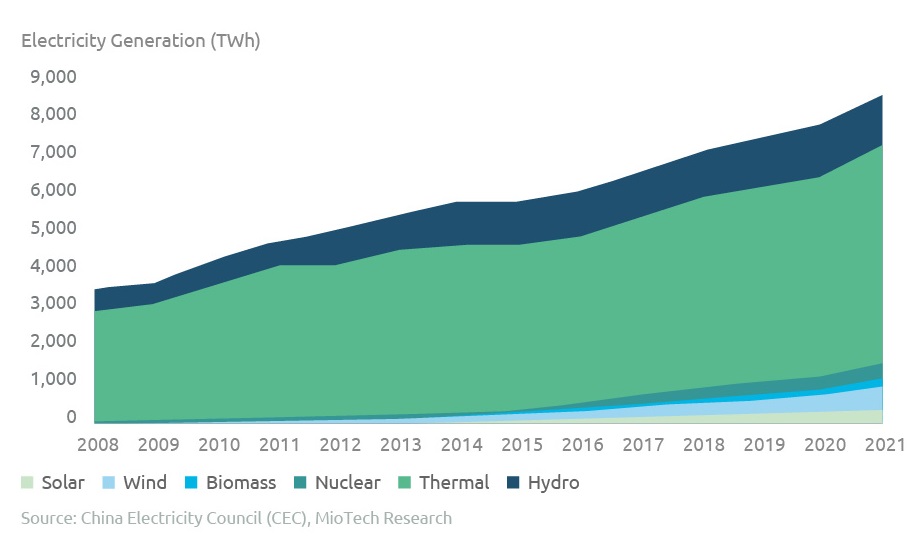
Coal still makes up the bulk of power generation in China – 63% in 2021 compared to the worldwide average of 36%. Natural gas accounts for just 3.6% of power generation in comparison to the global average of 23%.
To further advance the green agenda, China will need to do more to integrate renewable sources into the existing electric grid. Looking ahead, there are two critical areas on the supply side where this can be done in a scalable manner.
1. Retrofitting coal-fired power plants
Coal-fuelled power plants (CFPPs) remain the country’s primary source of electricity generation, although capacity has been declining over the past few years. The annual average full load hours of CFPPs fell by 16% from 5,305 hours in 2011 to 4,448 hours in 2021.
Exhibit 2: Average annual utilisation hours of coal-fired power plants in China, 2011 – 2021
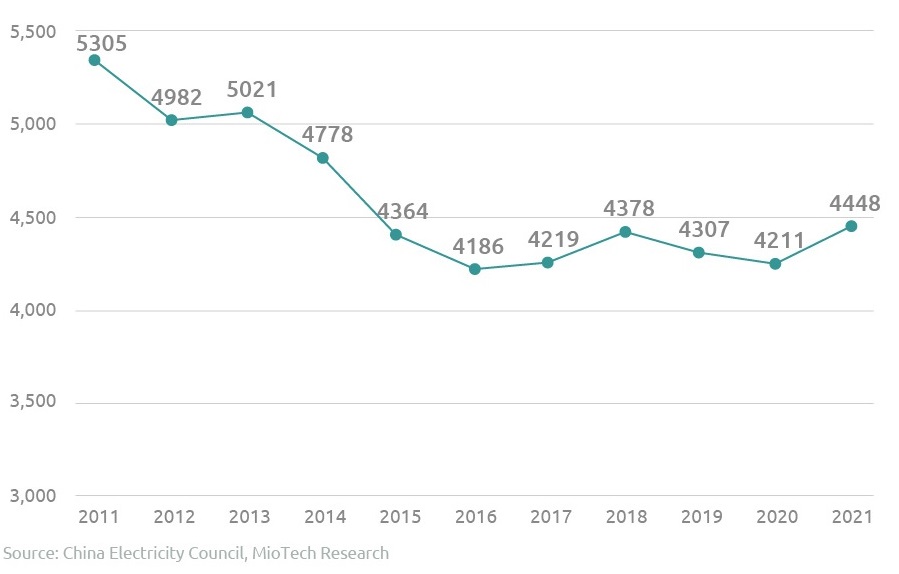
Instead of phasing them out entirely, retrofitting these power plants can assist in accommodating new renewable energy systems. Retrofitted CFPPs can bring flexibility to the peak shaving and valley filling approach to the power load, while also lowering costs. Retrofitted CFPPs can also maintain stable operation levels of about 20%, leading to lower carbon emissions, especially when combined with carbon capture, utilisation, and storage technologies.
2. Expanding energy storage systems
With the development of wind and solar energy power, there is strong potential for energy storage systems (ESS) to be widely used in commercial applications.
In China, three main forces are pushing for the development of ESS:
- Performance improvements in Lithium-ion batteries have led to a dramatic drop in costs.
- Government policy has set out proportional allocation requirements in terms of energy storage capacity for variable renewable energy installations.
- Further reform in the electricity market that would indirectly promote healthy demand for ESS.
We think that the installed capacity of ESS could reach 66 GWh by 2025, corresponding to a five-year compound annual growth rate (CAGR) of approximately 88%.
Exhibit 3: China electrochemical energy storage market size forecast (unit: RMB bn)
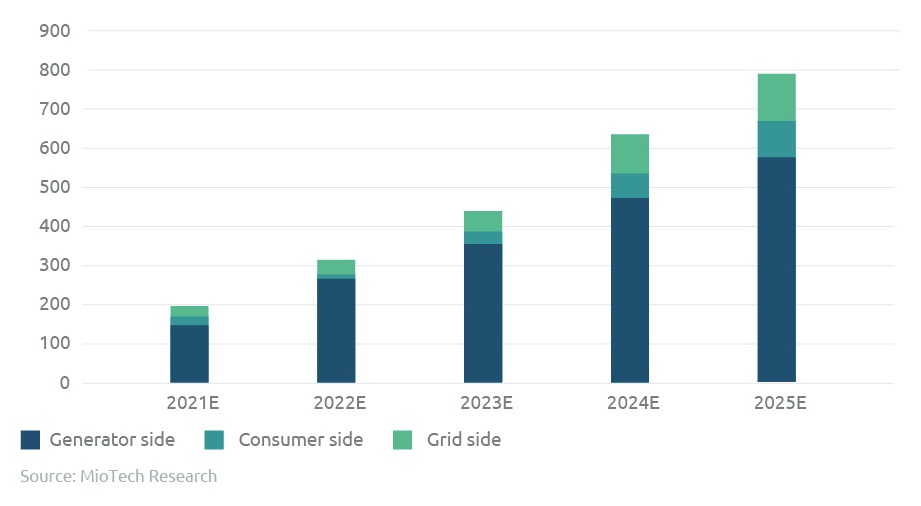
II. Changing energy demand patterns
While supply-side mechanics help promote the use of clean energy, evolving demand patterns are playing an equally vital role in China.
China has set long-term development targets for carbon peaking and neutrality at the provincial and municipal levels. Today, 17 out of 31 provincial administrations have rolled out policy documents relating to carbon peaking and neutrality.
These 17 provinces are also responsible for about 1.7 billion tonnes of carbon emissions, accounting for approximately 56.7% of the country’s total annual carbon emissions.
Exhibit 4: Carbon emissions (million tonnes of CO2e) of 31 provinces in Mainland China
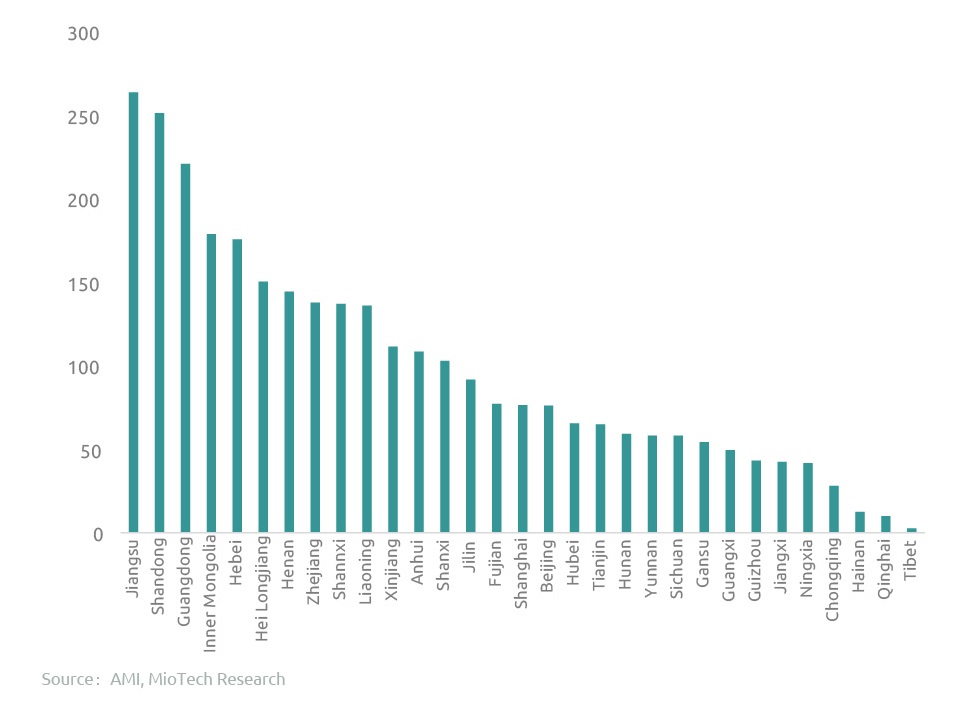
These provinces will need to make significant cuts in emission levels, and decarbonising certain industry sectors will be key.
1. Impact level 1: Industry
Recycling raw materials
Recycling steel, aluminium, paper, and plastic products have tremendous potential to reduce emission levels.
Our research shows that if the right moves are made, total carbon emissions can be reduced by 2,865 million tCO2e from 2022 to 2025. This is equal to the carbon sink potential of around 10m square kilometres of urban forest – close to the size of the whole of Europe – in one year. In 2022 alone, we forecast the recycling level of the four commodities to reach 670m tCO2e – almost three times the estimated annual carbon removal capacity of forests across Europe.
The recycling of steel, aluminium, paper, and plastic will reach a combined market size of RMB 1.4 trillion (US$ 195bn) by 2025, representing an annual growth rate of about 5%.
Corporates have stepped up their responsible waste management efforts. Based on 2020-21 data from all mainland A-share and Hong Kong-listed Chinese firms, we found a 46% YoY increase in these companies’ total recycled waste volume, while the average waste recycling rate also improved significantly from 60.5% in 2020 to 69.2% in 2021.
The increased quantity comes from a higher volume of recyclable materials, including scrap steel from the steelmaking process, end-of-life waste plastics as well as paper for packaging and other uses, among other industrial and commercial waste.
Exhibit 5: The average waste recycling rate of mainland A-share and Hong Kong-listed Chinese firms
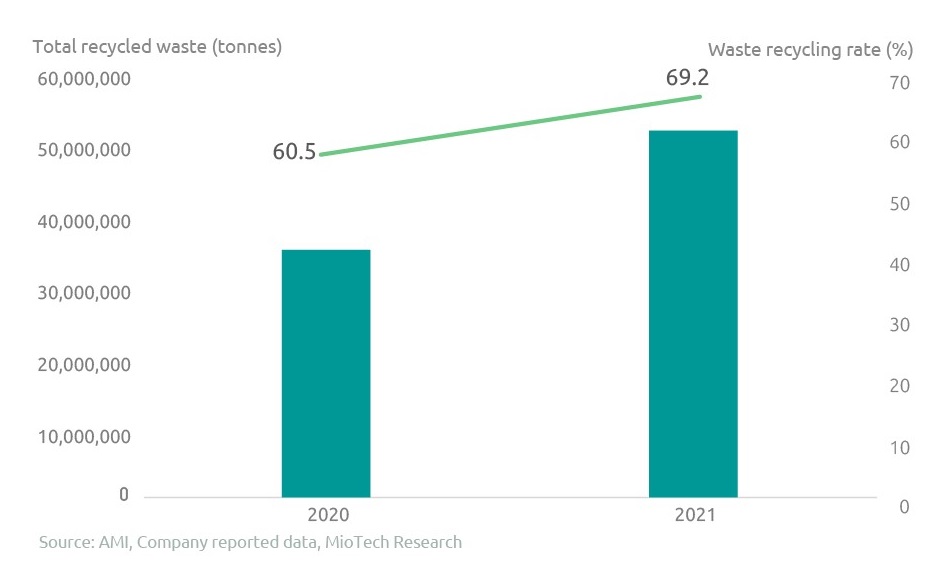
In addition, manufacturing companies are putting more emphasis on promoting the sustainable use of raw materials and the recycling of used products as part of the circular economy.
In 2020, out of all (2,675) industrial sector companies covered by MioTech (MICS), only six firms reported progress on promoting the sustainable use of raw materials and none disclosed product recycling initiatives. In 2021, by contrast, 70 companies shared about activities targeted at the sustainable use of raw materials and 37 companies reportedly established product recycling initiatives. Heavy industries reportedly consume the most steel, aluminium, paper, and plastic products.
Exhibit 6: Companies reporting initiatives supporting circularity in 2021, by sector
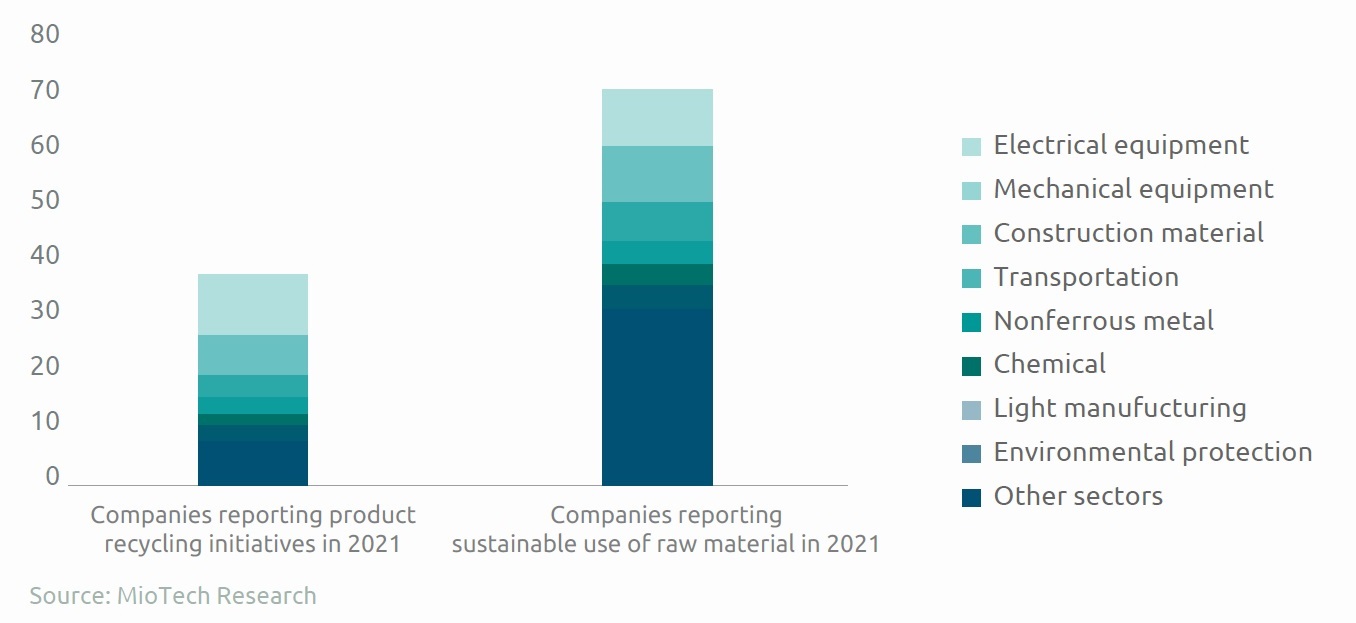
Improving the energy efficiency of electric motors
Electric motors are critical elements of the industrial process and can account for 70% of the total electricity consumption in the entire industrial sector. Replacing motors with more energy-efficient models can save between 5% and 10% in energy.
Cognisant of this opportunity, China’s Ministry of Industry and Information Technology (MIIT) issued the Motor Energy Efficiency Improvement Plan in 2021 that aims to phase out inefficient motors, significantly reducing energy consumption and emission levels.
As a result, the market growth rate of energy-efficient motors is likely to rise to about 20% a year, up from between 3% and 4% the year before.
At the same time, using variable frequency drives (VFDs) can also complement the increased adoption of high-efficiency motors. VFD is a type of motor controller that drives an electric motor by varying the frequency and voltage of its power supply.
These high-efficiency motors and VFDs are easy to install and do not require any additional modifications to existing industrial processes, making them easy green solutions.
Innovation in waste heat recovery technologies
High-temperature (above 400°C) waste heat recovery is a well-used technology for power generation. But there is also potential for medium- (100°C to 400°C) and low-temperature (less than 100°C) waste heat recovery to generate power.
Medium- and low-temperature waste heat recovery makes up a bigger proportion of total heat waste in industry. For instance, in petrochemicals, it accounts for 80% of total waste heat. Technological limitations and lower grade of waste heat have, up till now, made the recovery process commercially unviable.
But there is potential for such waste heat harvesting through a new technology called Organic Rankine Cycle (ORC). Industrial heat is passed through a heat exchanger that heats a process fluid with a lower boiling point than water into steam, which then enters a turbine to drive electricity generation.
In heavy industries, we estimate that medium- and low-temperature waste heat suitable for ORC recovery makes up about 39.6 Mtec in China. This means that the potential market size of such processes for medium- and low-temperature heat recovery can reach RMB 150bn (US$ 21bn) in the industrial sector from now to 2030. The current global market size for industrial waste heat recovery systems is estimated to be around RMB 18bn (US$ 2.5bn) per year.
2. Impact area 2: Buildings
Prefabrication on the rise
Prefabrication is a method of construction that produces much lower carbon emissions compared to traditional construction.
China, in its 13th Five Year Plan (FYP), had proposed that prefabrication construction would reach 15% in 2020. That target was exceeded and prefabrication accounted for 20.5% of total new construction in 2020.
In the 14th FYP, the Chinese government set a higher target of 30% by 2025, which we believe is achievable. Provincial governments have, in fact, set higher targets than the ministry. Local governments are equally on board because prefab cuts down noise, dust, and waste pollution.
Provincial governments, which include Jiangsu, Shenzhen, and Zhejiang, have also added prefab requirements as part of the land concession requirements, forcing the private sector to adapt as well.
According to MioTech data, there is an increased adoption of prefab by Chinese property developers and engineering companies. In 2020 and earlier, prefab was mainly implemented by large property developers, while in 2021, smaller businesses and regional construction companies have also started reporting their engagement in prefab construction.
Exhibit 7: Number of property development companies reporting the use of prefab in their ESG reports
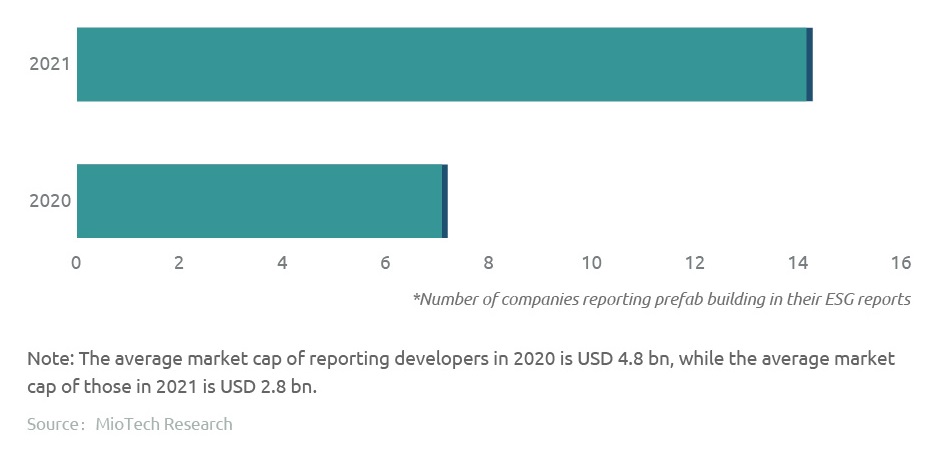
We estimate that prefab will account for between 32% and 38% of total new construction by 2025. By 2030, its market size should exceed RMB 5 trillion (US$ 700bn); and reach RMB 10tn (US$ 1.4bn) by 2060.
Building-integrated photovoltaics (BIPV)
Building-integrated photovoltaics (BIPV) are photovoltaic materials that are used to replace conventional building materials in parts of the building envelope such as the roof, skylights, or facades. This is in contrast to traditional BAPV, or building-applied photovoltaics, where the PV solution is installed on the existing surface of the building. Compared with BAPV, BIPV is an integrated model with better cost and performance profile.
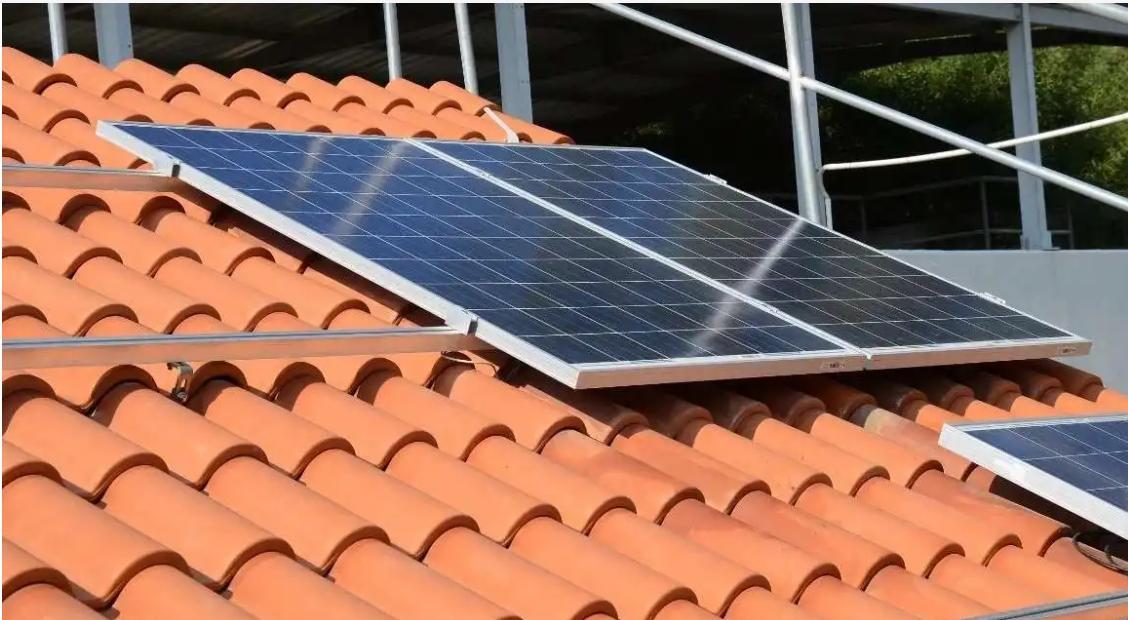
Building-applied photovoltaics (BAPV) system.
In particular, factory and commercial/office building rooftops offer significant potential for BIPV to scale. We estimate that over one-third of BIPV will be installed on factory roofs, which means the BIPV installations will exceed 46 GW by 2025, up from 1 GW in 2021. The total market size should reach RMB 110bn (US$ 15.4bn) by 2025.
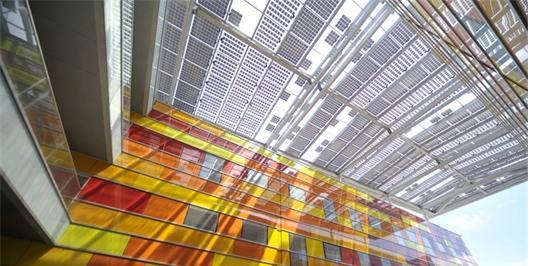
Building-integrated photovoltaics (BIPV) system.
Promoting the integration of solar PV with new buildings has been an inevitable trend for property developers in 2021. We saw 57 companies install PV in their commercial/industrial property developments in 2021, in comparison to only 27 in 2020.
Exhibit 8: BIPV installation projections (GW), 2021E and 2025E
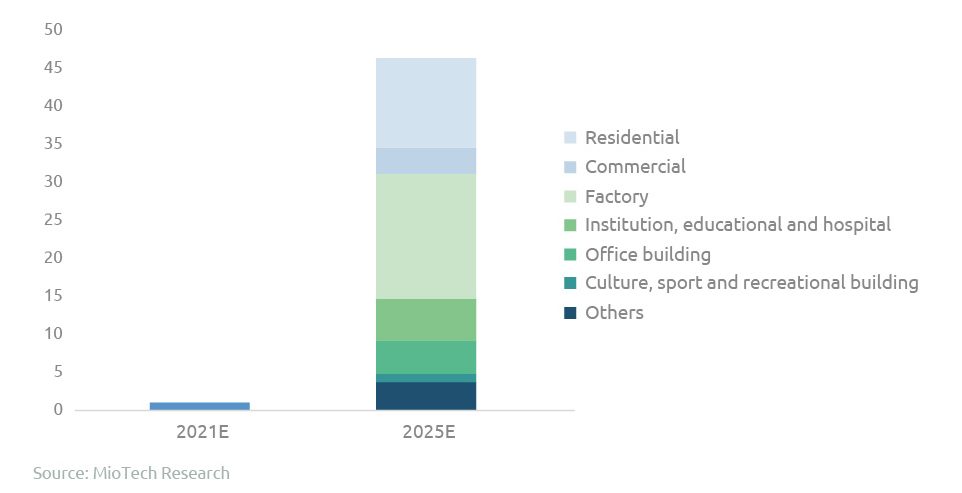
Soaring demand for air-source heat pumps
Air-source heat pump technology has improved meaningfully over the past few years. Compared with resistance heaters, air-source heat pumps can guarantee 50% in energy savings.
At the same time, product life and reliability have also improved, with the life span of such residential pumps averaging between 15 and 25 years. New national standards have also been introduced, allowing for the rapid promotion and development of the heat pump industry.
The technology should fill a gap that is growing in China’s decentralised heating market, composed of both rural residential buildings in northern cities and commercial and residential buildings in the southern parts of China.
As such, demand for air-source heat pumps is expected to soar. By 2025, we expect annual sales of air-source heat pumps to reach RMB 25.7bn (US$ 3.6bn) up from RMB 7.8bn (US$ 1.1bn) in 2021, a CAGR of 35%.
III. GIC’s green investments in China
GIC has been actively investing in China over the years, including in green projects in the country across multiple sectors and industries. Here, we feature efforts by the GIC public equities, real estate and private equity teams.
A “whole of portfolio” approach for ESG investing in China’s public equity market
The public equities universe in China provides multiple opportunities for bottom-up investors to capture the themes of electrification, clean energy, energy efficiency, and green materials, to name a few. These opportunities cover battery technology, industrial upgrades across traditional machinery, renewables, as well as power utilities and equipment, thermal management, and green materials. At GIC, we engage with a whole portfolio of companies that play tangible roles in China’s energy transition, whether it is an established state-owned enterprise with an energy transition angle or a future technology leader with an innovative decarbonisation solution.
More importantly, engagement and guidance provided to investee companies on their ESG journey are critical to ‘growing the pie’ and value adding to our portfolio. We remain committed to these themes for the long term.
The tallest sustainable office building in Beijing Lize

According to the UN Environment Programme (UNEP), cities account for three-quarters of global CO2 emissions, with transport and buildings considered to be among the largest contributors. Energy-efficient buildings form a crucial part of the solution, especially in dense urban areas such as Beijing and Shanghai.
In 2019, GIC acquired the tallest office building in Beijing’s Lize financial business district. The 42-storey building is a Grade-A asset and is located along Lize Road. It was designed with multiple energy-saving and environmentally friendly features, including a carbon dioxide sensor to improve fresh air supply and boost energy efficiency, as well as heating recovery units in its heating, ventilation, and air-conditioning (HVAC) system. The building also uses LED lighting and water-efficient products in its washrooms.
The project, which qualified for green financing, has received both the LEED Gold label and a two-star rating in China’s three-star evaluation standard for green buildings.
The power of digital in the energy transition
Digitalisation and technology are key tools to accelerate the low-carbon transition. Combining artificial intelligence with the internet of things, Singapore-headquartered Envision Digital’s net-zero operating system, EnOS™, assists organisations around the world in managing the production of renewable energy and maintaining efficient consumption across their operations. The system connects and oversees more than 220m smart devices and 560 GW of energy assets globally. The company’s growing ecosystem of more than 500 customers and partners spans retail, industrial, government, energy, and transportation, among others.
Envision is also working on the world’s first net-zero industrial park in Ordos, Inner Mongolia, with the aim of accelerating the low-carbon transition of the traditionally coal-producing region. The park will be powered by a combination of clean energy sources, including wind, solar and hydrogen, will integrate the supply chains of key low-carbon solutions such as electric vehicle and battery manufacturing, and will be connected by an electric truck transportation network.
Access the pdf version of the report by clicking on “Save as PDF”.







